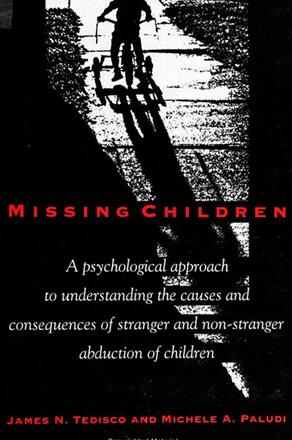
Missing Children
A Psychological Approach to Understanding the Causes and Consequences of Stranger and Non-Stranger Abduction of Children
Alternative formats available from:
Focuses on variables that assist in confronting and preventing child abductions, including teacher training, public education and awareness, psychotherapeutic techniques for families and friends of abducted children as well as the children themselves.
Description
Child abduction is the most widespread form of child victimization studied. In 1992 alone, a total of 27,553 cases of missing children were reported in New York State through the Missing Children Register. The majority of missing children cases involved suspected runaways. Abduction cases accounted for one percent of the total report; those committed by family members comprised the most frequent form of abduction (as opposed to abduction by strangers). In addition, 88 percent of the children reported missing were age 13 or older, 60 percent were girls, and 58 percent were white.
Child abduction is a serious socio-economic problem. Until now there has been no text that addresses the incidence, psychological dimensions, and explanatory models of child abductions. This book fills a need by focusing on variables that assist in confronting and preventing child abductions, including teacher training, public education and awareness, psychotherapeutic techniques for families and friends of abducted children as well as the children themselves.
James N. Tedisco has been a member of the New York State Assembly since 1982. In his first year in the Assembly, Tedisco was appointed Ranking Republican member on the Committee on Children and Families. He also served on the Assembly Committees on Aging and Education, and Child Abuse. In 1983, as a result of his work on behalf of missing children, Tedisco was appointed Chairperson of the Assembly Republican Task Force on Missing Children. Tedisco also worked in the field of education from 1973 to 1982, first as a guidance counselor, then as a special education teacher. His expertise as a psychologist, educator, and legislator is integrated in this book. Michele A. Paludi is a developmental psychologist specializing in the psychology of women and victimization. She is Principal of Michele Paludi and Associates, Consultants in Sexual Harassment and offers education and training in issues related to sexual harassment at elementary and secondary schools, colleges and organizations. Paludi has collaborated with Assemblymember Tedisco as his Legislative Advisor on Women's Issues. She is the author of Ivory Power: Sexual Harassment on Campus, and Exploring/Teaching the Psychology of Women: A Manual of Resources, and Sexual Harassment on College Campuses: Abusing the Ivory Power, all published by SUNY Press.
Reviews
"Even though parents believe they are capable of keeping their children safe, few are aware of the plethora of ways child abductors can achieve their goals. The public needs to be aware that most child abductions occur at the hands of parents or other family members. The array of resources and tips contained in this volume are invaluable. The topic is significant for every parent, teacher, daycare worker, all police personnel, all child protective services workers, and all therapists. " -- Paula K. Lundberg-Love, University of Texas-Tyler